12.12.2017
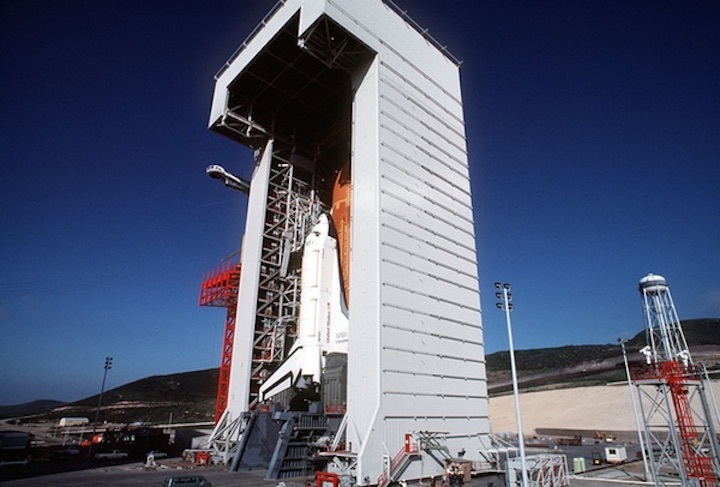
The Air Force considered launching shuttle missions from Vandenberg, or even from Florida, to retrieve a reconnaissance satellite, bring it back to Earth, and refurbish and refly it. (credit: US Air Force)
-
The James Bond movie You Only Live Twice started with a covert satellite sneaking up on an American spacecraft in orbit, swallowing it like an alligator and smuggling it back to Earth. But by the early 1980s, the American National Reconnaissance Office (NRO) began contemplating launching a space shuttle north out of Florida, dropping its solid rocket boosters off of Daytona Beach, and heading inland over the mid-Atlantic states overflying Cleveland, Ohio, and Canada. Once in orbit, it would open its payload bay doors, grab hold of a top-secret American HEXAGON reconnaissance satellite the size of a school bus, and bring it back to Earth. It was an audacious plan, not only because it would overfly the American and Canadian landmasses on its way to orbit, but also because it would first show up on Soviet radar as it rose over the North Pole—and they might be a little upset. “The political problems were agreed to be most difficult,” an NRO memo declared with remarkable understatement.
Deep Black and the shuttle
The space shuttle offered greater performance capability than the Titan IIID used to launch the HEXAGON reconnaissance satellite in the 1970s. HEXAGON was then the largest and heaviest robotic spacecraft ever built and the most obvious choice to switch to a more capable launch vehicle. By the mid-1970s, the NRO had under contract the seventh thru twelfth HEXAGONs, designated Block II, and the next six vehicles, designated Block III. The Block II spacecraft weighed 10,206 kilograms (22,500 pounds) without their launch vehicle fairings. NRO officials estimated HEXAGON could grow up to 11,022 kilograms (24,300 pounds) for shuttle launch. Although it is unclear how this extra mass would be allocated beyond a few required modifications, such as structural additions for mounting in the shuttle’s payload bay, the additional mass margin conceivably could have enabled more fuel and a longer lifetime for the spacecraft.
| “The political problems were agreed to be most difficult,” an NRO memo declared with remarkable understatement. |
By the time the Block II satellites were under construction, NRO officials made some decisions about HEXAGON’s future. They decided that the HEXAGON would not transition to the shuttle but would continue to launch atop Titan rockets. Another NRO decision was to build a total of 20 HEXAGONs. After several launches per year following the first HEXAGON launch in 1971, the launch rate settled to one per year starting in 1976. At that rate, the HEXAGON program would end in 1984, by which time a replacement needed to be flying. That meant that development of a replacement probably had to start no later than early 1979, and it would use the space shuttle to reach orbit.
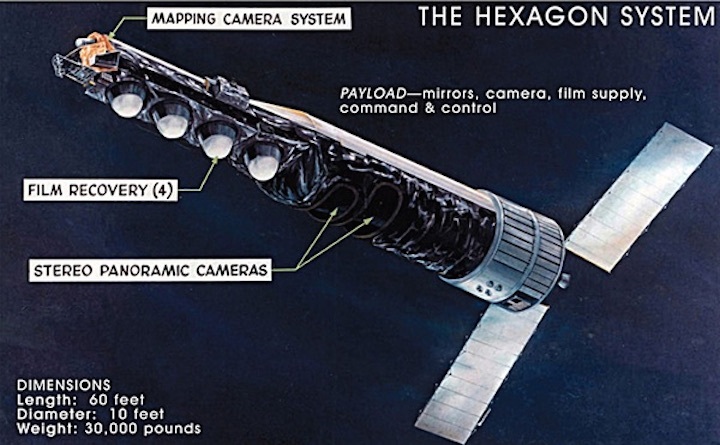
The bus-sized HEXAGON reconnaissance satellite was the largest intelligence satellite launched by the United States in the 1970s. Throughout that decade and into the early 1980s, the National Reconnaissance Office evaluated launching, and recovering HEXAGONs using the space shuttle. (credit: NRO)
-
For the next several years, NRO officials evaluated several shuttle-based options for following on to the HEXAGON program. These started with a series of studies under the Wide Area Surveillance Payload (WASP) project, and then continued as a series of more detailed studies under the code-name ZEUS. (See: “Black ops and the shuttle (part 2),” The Space Review, August 7, 2017)
By the mid-1970s, HEXAGON’s days were numbered, but not because film-return satellites were obviously technologically obsolete. The NRO had launched its first KH-11 KENNEN in December 1976. The KENNEN, unlike HEXAGON, used a digital imaging system for recording images. (The NRO plans on declassifying information about the early KENNEN satellites early next year.) But KENNEN was designed for high resolution and nearly instantaneous readout of its images, not for searching vast areas of territory looking for changes. In order to image large areas fast, film was the only realistic choice.
After ZEUS was canceled in 1980, one option that NRO officials considered was extending the HEXAGON program beyond 20 vehicles. Starting with Satellite Vehicle #21, HEXAGON could be designed for launch on either the shuttle or a Titan 34D rocket. By mid-1979, NRO officials also considered the possibility of launching vehicle #20 on the shuttle. They determined that a decision to do so would have to be made by October so that the vehicle could be modified for shuttle launch in 1984.
If instead NRO officials decided to launch HEXAGON 20 on a Titan 34D and procure HEXAGON #21 and launch it on the shuttle, the NRO would have until late 1980 before having to sign final contracts with the satellite manufacturers. Because the shuttle offered more lifting capability than a Titan 34D, HEXAGON #21 could be upgraded with the addition of a fifth reentry vehicle. There was no more room on the film supply reels to carry additional film, so the primary benefit of only adding another reentry vehicle would be to reduce the time between reentries, thus shortening the time between when a photo was taken and when analysts were looking at it on the ground.
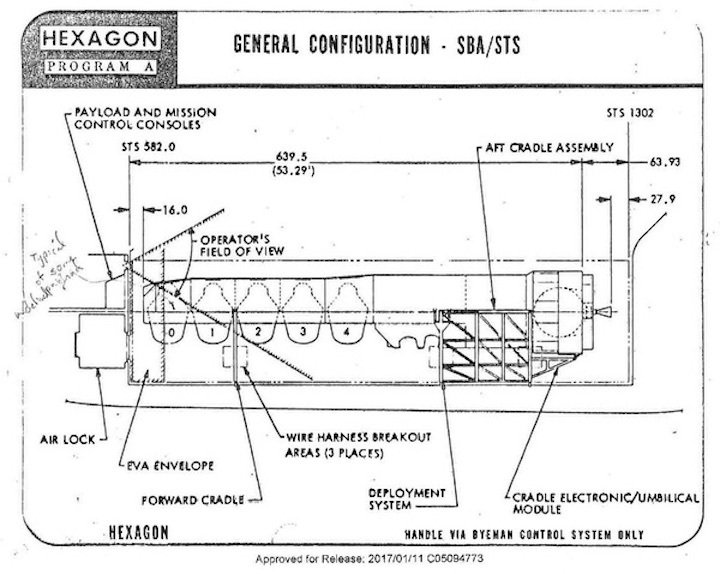
Declassified image showing how a HEXAGON could be modified to take advantage of the shuttle's capabilities compared to its Titan launch vehicle. One possible modification was adding a fifth film return vehicle to enable quicker recovery of exposed film. (credit: NRO)
-
But these proposals for building more HEXAGONs and launching them on the shuttle were rejected in either late 1979 or early 1980. According to a declassified interview with former NRO Director Martin Faga conducted by NRO historian Gerald Haines, the NRO determined that they could modify their existing KH-11 KENNEN digital imaging satellites to produce search imagery equivalent to what HEXAGON had provided and that ZEUS was supposed to provide. The official history “The Hexagon Story” confirms Faga’s statement. Although details on specific decisions remain somewhat sketchy, NRO officials clearly decided not to purchase any more HEXAGON vehicles after #20 and continue to launch them only on expendable rockets, not the shuttle.
| “One of the key terms was ‘digital rectification,’ making everything on a common scale, which the EO program manager sarcastically said sounded like something a proctologist might do to you.” |
According to a person who worked for the NRO at the time, any talk of extending HEXAGON production beyond the 20th vehicle was never very serious. “There was no real thrust to add more of the film-based systems,” he explained. “The emphasis was on stretching out the film programs to cover the start-up, initialization, and early-on teething issues associated with the new technologies of the electro-optical system, and there were many. Any talk of Hex-21 was only about how long could we drag out the decision to build it before the engineering and manufacturing capability disappeared at the contractors.” The heart of the HEXAGON was its ingenious optical bar cameras and its system for threading film through them at very high speed. “We had even gone so far as to procure and manufacture long-lead optical bar spares to keep that capability alive,” the official explained. “They were subsequently identified to be used on ZEUS before it was canceled. But the main reason was to make sure that electro-optical worked before we gave up all hope for what we had.”
The decision to end the HEXAGON program at 20 spacecraft and to rely on a non-film-based replacement would eventually have long-lasting consequences.
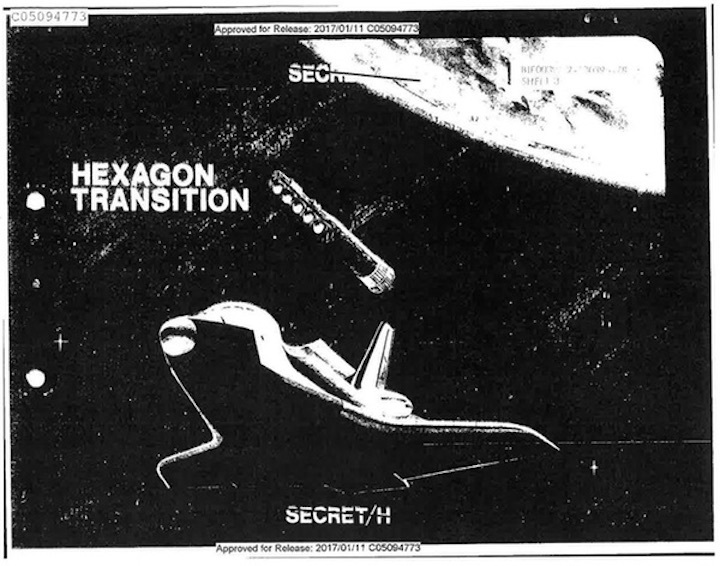
Declassified artist image of a HEXAGON being deployed from the shuttle. By the early 1980s, the National Reconnaissance Office evaluated recovering some of the final HEXAGON satellites after they had completed their missions in orbit. (credit: NRO)
-
SLC-6
The shuttle had originally been planned for launch in 1979. Various development problems, most involving the powerful Space Shuttle Main Engines and the thermal protection tiles, had pushed the first launch back by two years, until April 1981, when Columbia finally roared off its Florida launch pad.
By the mid-1970s, the Air Force had also begun planning for shuttle launches from Space Launch Complex-6 (known as “Slick-6”) at Vandenberg Air Force Base in California. In 1975, the goal had been for operational capability at SLC-6 by 1982, but according to Dennis Jenkins in his recently published three-volume history of the space shuttle, program managers never considered this schedule realistic.
A newly-declassified document reveals that in early 1979 the NRO began considering its first shuttle mission, to be launched from SLC-6. Although the identity of the payload for this first mission is deleted from the document, it was publicly revealed decades ago to be the first of a new series of radar imaging satellites. This mission could occur at the earliest by June 1984 aboard shuttle Discovery. But the NRO noted that this would be a new vehicle, a new pad, and a new satellite, which was a combination that made NRO officials uneasy. They preferred that Discovery fly at least one mission from Florida before the NRO mission from Vandenberg. But various problems with SLC-6 resulted in its earliest availability being slipped from summer 1984 to October 1985, prompting the NRO to reconsider its use of shuttle.
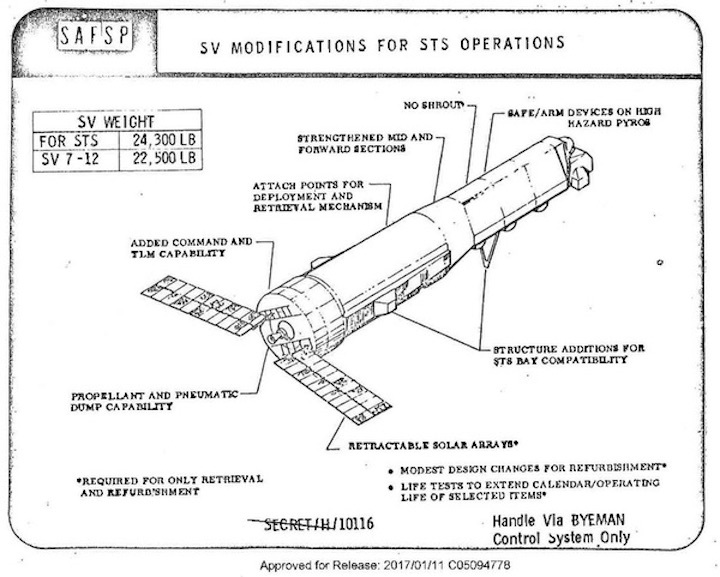
Declassified illustration showing some of the modifications required for launching a HEXAGON inside the shuttle bay. Although this was ruled out by the late 1970s, a few years later NRO officials looked at methods of recovering the large satellite at the end of its mission. (credit: NRO)
-
Recovering the satellites
Because of a number of complicated issues, including modifications at the Titan 34D launch pad at Vandenberg, the NRO did not launch a HEXAGON satellite in 1981, the first time in ten years that the United States did not put a HEXAGON in orbit. In fact, this was the first time that the United States did not attempt to launch any search satellites since the first CORONA launch in early 1959.
| By spring 1982, NRO officials had begun considering a new option: launching the space shuttle from Vandenberg and rendezvousing with a HEXAGON in orbit and bringing it back to Earth for refurbishment. |
HEXAGON vehicle 16 had been launched in June 1980, and the NRO leadership decided to stretch out its operations into 1981 to cover the looming gap in search imagery coverage. Because cloud cover over the Soviet Union during the winter precluded most photographic reconnaissance operations, the NRO stopped taking photos with the vehicle in the fall and boosted it into a higher orbit with one remaining reentry vehicle onboard, letting it drift such that by the spring it would be back in position for normal operations. “During that time we ran some short ops just to keep the pressure in the film path up and access some ad hoc targets,” the former NRO official explained. “This was called Zombie Mode. It was followed by a return to active mission for the duration of bucket 4. We would have launched vehicle 17 but a failure in the payload sequencer precluded any ’81 attempt. Plus, it fit into the overall NRO strategy to stretch things out. Optimists might call it serendipity, I call it bad luck.”
By the early 1980s, the final four HEXAGON vehicles, numbers 17 thru 20, were under construction. Vehicle number 17 launched in May 1982, and the NRO planned annual launches of the remaining satellites. That same year, an NRO official declared that the HEXAGON program would have its last flight in 1985 and “no transition to the shuttle is planned.”
Although the NRO leadership had decided to modify KENNEN to take over HEXAGON’s search mission, apparently there were some within the organization who had doubts about this new capability and worried about a gap in coverage. HEXAGON had operated reliably—often spectacularly—for over a decade, and some people were unwilling to give it up. According to the former NRO official, pressure for extending the HEXAGON’s service came from the Defense Mapping Agency (DMA), along with the Defense Intelligence Agency (DIA). “DMA was the main backer for HEXAGON at this point, although DIA was still a strong proponent,” he explained. “DMA had a large set of requirements for mapping and really had no way to exploit the digital data that the electro-optical system provided. Their production processes and equipment were all geared toward hard copy (film). It would require a lot of money and time to get them over to digital exploitation. One of the key terms was ‘digital rectification,’ making everything on a common scale, which the EO program manager sarcastically said sounded like something a proctologist might do to you.”
In January 1982, the NRO had launched one of its last GAMBIT high-resolution reconnaissance satellites in a configuration known as “Dual Mode.” The GAMBIT flew to a higher than normal operational orbit. At this higher altitude the GAMBIT could take photographs of much larger swaths of territory. But because of a flaw in the separation pyros for the reentry system, the photographs from this mission could not be recovered.
By spring 1982, NRO officials had begun considering a new option: launching the space shuttle from Vandenberg and rendezvousing with a HEXAGON in orbit and bringing it back to Earth for refurbishment. Recovery and reuse of HEXAGON had been ruled out by the NRO in 1975, but recovery and reuse of the last remaining vehicle offered an opportunity to get a 21st mission without actually building a new spacecraft.
One possibility that the NRO considered was recovering HEXAGON vehicle 18, then scheduled for a 1983 launch. Considering the lifetime of the satellite, this would have required a shuttle launch in 1984, and Vandenberg’s Slick-6 was not scheduled to be ready until late 1985. By August 1982, the NRO evaluated a polar orbit shuttle launch from Florida, and performed basic trajectory simulations for such a flight. With an almost empty shuttle bay (except for HEXAGON handling equipment), the shuttle would fly north over the Atlantic Ocean, drop its SRBs, and then head inland, over South Carolina, North Carolina, Virginia, West Virginia, Ohio, and Canada. The Soviet Union would have detected the shuttle as it rose over the North Pole, and then crossed over Soviet territory.
The vehicle 18 recovery with Florida polar launch was always a long shot, and it was apparently quickly rejected. That left the possibility of recovering either vehicle 19, scheduled for launch in 1984, or vehicle 20, scheduled for launch in 1985.
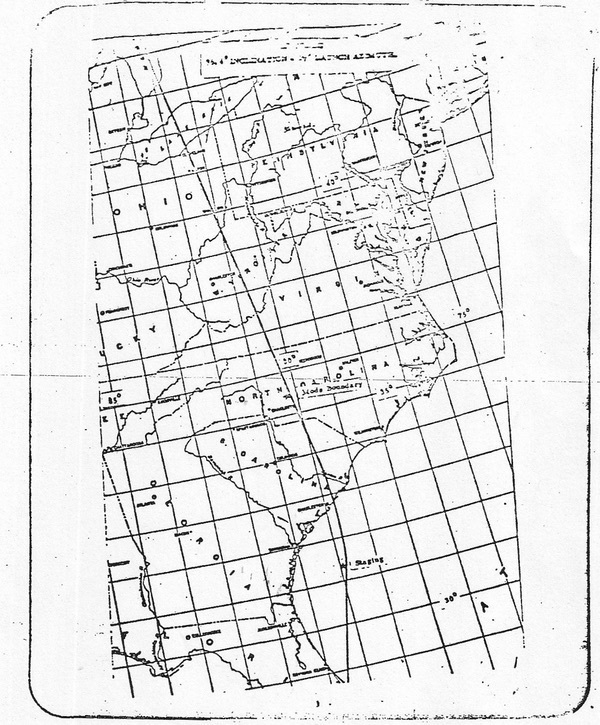
Declassified 1982 map showing the trajectory of a space shuttle launch to recover a spent HEXAGON reconnaissance satellite. This trajectory would have been required to recovery HEXAGON vehicle 18 because the Vandenberg, California shuttle launch site would not have been available in time. The shuttle would have launched with its payload bay nearly empty. It would have dropped its SRBs off the coast before heading over the continental United States, crossing over Canada, and entering a polar orbit. NRO officials were wary of the political problems of such a mission. (credit: NRO)
-
Intelligence gaps
Although the justification for HEXAGON recovery is deleted in one declassified document, the undated document probably from late summer 1982 indicates that some at the NRO were concerned about the availability of search imagery in the coming years. One prediction was that by 1985, the requirements for HEXAGON would be 70 percent for intelligence collection and 30 percent for mapping, charting, and geodesy (MC&G). But beyond 1985 “baseline imaging mix will not meet all collection requirements,” the document stated. There would be “critical shortfalls in MC&G and HRI [high resolution imaging].” Presumably, this was because the document’s authors did not believe that the KENNEN was going to be able to accomplish the entire mission. Refurbishing a HEXAGON recovered from orbit could relieve the burden on the KH-11 KENNEN digital imaging satellite.
One of the dilemmas facing the KENNEN system was that there was always a higher demand for high-resolution imaging of targets than there was for general search. “This came to haunt the community when in high-density target areas point targets always out prioritized the search requirements such that new high-value targets were not discovered until they were already instantiated, and in some cases accidently captured and exploited,” the former NRO official explained. The advocates for using the KENNEN system to do the search mission argued that they needed more satellites, more ground stations, and more people to interpret the imagery, as opposed to continuing the HEXAGON program.
Although the capabilities of its replacement are unknown, what is known is just how incredibly good the HEXAGON was at its job. In 1979, HEXAGON 15 imaged 49.8 million square kilometers (29.6 million square nautical miles) in stereo, a tremendous amount of territory. The HEXAGON could cover over 685 kilometers (370 nautical miles) east to west in a single photograph, roughly equal to the distance from Cincinnati, Ohio to Washington, DC, and that imagery would enable objects on the ground smaller than 0.6 meters (two feet) to be seen, although that was when the target was near nadir, and off-axis ground resolved distance, with longer slant ranges, was not as good. Everybody who was familiar with it considered the HEXAGON to be impressive and capable of providing a wealth of intelligence data from each mission, and many hated to see it retired.
The proposed HEXAGON recovery and refurbishment mission would cost additional money, starting with spending $24 million in fiscal year 1983, followed by a lot more as the project progressed. Some of the money was required to modify the satellite for retrieval, including adding trunnions, a grapple fitting, relocating one antenna, and fitting another jettisonable antenna. “The mods to shut off and dump the propellant as well as jettison the arrays are not simple mods,” the former NRO official explained. “Also the double redundancy/safing required for any payload going into the shuttle bay would have been extensive.” A cradle for holding the big satellite in the payload bay would have to be built. There were also costs associated with integration and analysis and qualification testing.
| The recently declassified documents on shuttle retrieval and re-flight of HEXAGON do not indicate why the mission was rejected. The document trail goes cold at the end of 1982. |
Although most depictions of the HEXAGON in the shuttle’s payload bay show it with the cameras facing the bottom of the bay for launch, the drawings of the on-orbit recovery operation show the shuttle with the HEXAGON rotated 180 degrees and its cameras facing up. During launch of a HEXAGON in the shuttle, the four large Satellite Reentry Vehicles would have been heavy, so pointing them toward the payload bay floor would have lowered the center of mass in case the shuttle had to land with the HEXAGON in the payload bay. In contrast, when the shuttle rendezvoused with a depleted HEXAGON in orbit, those heavy SRVs would be gone, and it made more sense to bring the satellite into the bay with its large upper forebody at the bottom of the payload bay, lowering the center of mass.
The NRO also analyzed the time required to refurbish the satellite vehicle after recovery, determining that it would take 16 months and would be available for relaunch in early to mid-1987 depending upon the retrieval date.
One relatively minor change to the satellites mentioned in one of the documents actually indicated a major operational change: the aerial recovery option for the satellite reentry vehicles would be eliminated and they would be intended for water recovery only. The reason for this was that the Air Force planned to retire the 6594th Test Group operating at Hickham Air Force Base on Oahu, Hawaii. The Test Group had over 500 personnel operating a fleet of specially-modified C-130s along with helicopters. The C-130s were equipped to snatch HEXAGON reentry vehicles out of the sky using a cable, and the entire fleet of aircraft was kept at a very high readiness level, making the 6594th quite expensive to support. For the refurbished missions, the reentry vehicles would simply go into the water and be fished out by a ship or helicopter. The modification for the reentry vehicles was simple: the existing vehicles had a salt water plug at their bottom that would dissolve after 24 hours so that they would fill with water and sink, preventing their recovery by the Soviets. This plug might have to be replaced with one that would last longer.
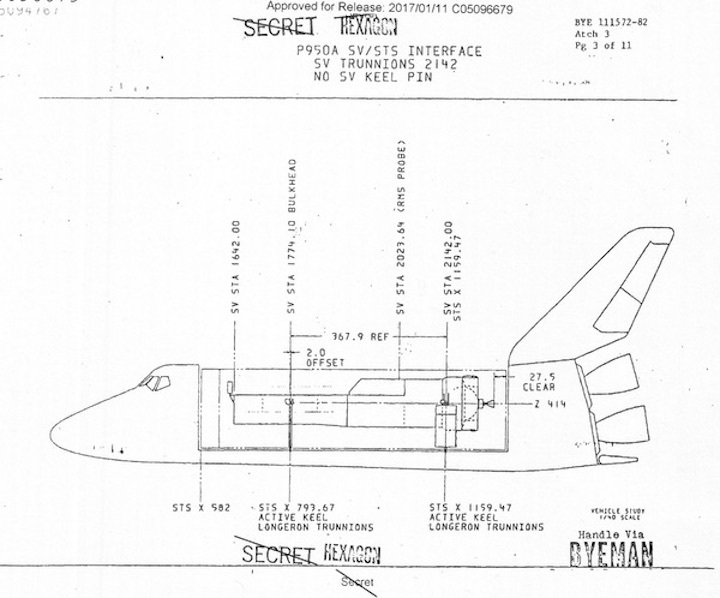
Declassified image showing how the HEXAGON satellite would have been mounted in the shuttle bay after recovery in orbit. In contrast to images showing how the HEXAGON would have been launched in the shuttle, the vehicle would have been mounted with the satellite forebody near the payload bay floor, and the cameras pointed up, out of the bay. (credit: NRO)
-
Although the HEXAGON was a mature and well-understood system, it had been designed to be both expendable and fly on a Titan rocket, not a crewed spacecraft. Adapting it to come back in the shuttle required that it be rendered safe enough that it would not endanger the astronauts. It also was not designed for the high horizontal loads it would experience when the shuttle touched down on a runway. Like most spacecraft, it was designed so that once it was put together it would stay together; it was not designed to come apart. There was also one particularly thorny issue to contend with: while the HEXAGON’s camera was built, a film leader was initially threaded through the film path and the rest of the camera system was then assembled around it. That leader was then used to pull the mission film through the camera. When the used HEXAGON was brought back to Earth, there would be no film running through the film path, and thus the camera system would have to be taken apart in order to re-thread it.
Getting SLC-6 ready in time
The NRO’s HEXAGON recovery assessment was based upon the assumption that Vandenberg’s shuttle launch facility would be ready by October 1985. The shuttle mission would involve a joint NASA-USAF crew including 1-2 Manned Spaceflight Engineers, the term the Air Force used for military astronauts who would fly on the shuttle. In 1979, the Air Force had announced the selection of ten MSE candidates from all four branches of the service, but only a few ever got to fly. One of them, John Brett Watterson, worked in the Air Force Special Projects Office, the West Coast office of the NRO.
After launch from Vandenberg, the shuttle would phase its orbit to rendezvous with the HEXAGON. As it neared the big satellite the HEXAGON would be safed, including turning off its reaction control system and jettisoning its solar arrays. The shuttle would grapple it and bring the HEXAGON into the payload bay where it would be berthed and then powered down.
By November 1982, several contractors, notably Lockheed and The Aerospace Corporation, were conducting detailed studies of retrieval and reflight of either HEXAGONs 19 or 20, and concluded that both vehicles had sufficient fuel for 290-day missions followed by six months of in-orbit storage awaiting shuttle retrieval. The working plan was for a single re-flight of possibly both spacecraft. At the end of its re-flight mission, the reused spacecraft would be de-orbited into the ocean.
If the NRO had decided in 1982 to fly the retrieval mission a few years later, Vandenberg’s SLC-6 would have been ready for the shuttle launch. By late 1984, SLC-6 was mostly complete and the NASA administrator announced that an October 1985 shuttle launch from Vandenberg was ambitious but feasible, with a second Department of Defense launch scheduled for September 1986. Cautious Air Force officials pushed back on that schedule a bit, and by October 1985 the Air Force declared Vandenberg operational and ready for a summer 1986 first launch carrying the unclassified Air Force Teal Ruby satellite.
The recently declassified documents on shuttle retrieval and re-flight of HEXAGON do not indicate why the mission was rejected. The document trail goes cold at the end of 1982. The most likely explanation is that any gap in coverage between the last HEXAGON mission and the advent of its replacement, the modified KH-11 KENNEN, was deemed acceptable by the NRO, although the former NRO official says that this was not a unanimous opinion.
The plan had been to launch the remaining HEXAGONs in 1983, 1984, and 1985. But the 19th vehicle experienced a number of problems during its 1984 mission: only three of its four reentry vehicles were recovered, and the mission was limited to only 180 days because of a massive command system failure. These problems prompted a delay in the launch of the 20th and last HEXAGON, which slipped into 1986. With the 1986 HEXAGON launch, a retrieval mission could conceivably have launched from Vandenberg in 1987, and HEXAGON #20 couldhave been refurbished and reflown on a Titan rocket in 1988 or 1989. But such a decision would have had to be made in 1982 or early 1983, when construction on vehicle 20 commenced.
| A few years later, something happened that highlighted just how much the intelligence community had lost when they retired the big bird. |
According to independent satellite observer Ted Molczan, the first five KENNENs had been launched between December 1976 and November 1982 into orbits with perigees around 270 kilometers and apogees around 500 kilometers. But in December 1984 the NRO launched the sixth satellite into an orbit with an apogee around 700 kilometers, and by late July the fifth satellite raised its apogee to similar altitude. These higher apogees gave the KENNEN satellites longer lifetimes and greater area coverage in 1985, the same year that the NRO had skipped launching a HEXAGON satellite for only the second year since 1971.
Molczan notes that historical orbital tracking data from 1985 indicates that on August 12, 1985, KENNEN 6 raised its orbital apogee again, this time to over 900 kilometers, and one day later KENNEN 5 was de-orbited. The reason for both these actions became clear only a few weeks later when a replacement for the de-orbited fifth vehicle sat atop a Titan 34D on a Vandenberg launch pad.
But the late August 1985 launch failed when the Titan rocket suffered an explosion. After that, the sixth satellite vehicle raised its orbit a bit more, to 1,000 kilometers, which extended its lifetime so that another one could be built to pick up the slack. All subsequent satellites of the type have had orbits ranging between 250 kilometers at perigee and 1,000 kilometers at apogee. Originally, when a satellite was at perigee it would be in sunlight, but at apogee it would be in darkness. In order to do the search mission in sunlight, the satellite had to be launched into a plane 180 degrees from the satellite that was optimized for high-resolution imaging. Eventually, the electro-optical satellites took over the missions of both the retired GAMBIT and HEXAGON film-return satellites. The last GAMBIT mission launched in 1984. The last HEXAGON mission was scheduled for April 1986. The end of the era for American film-return satellites was now in sight.
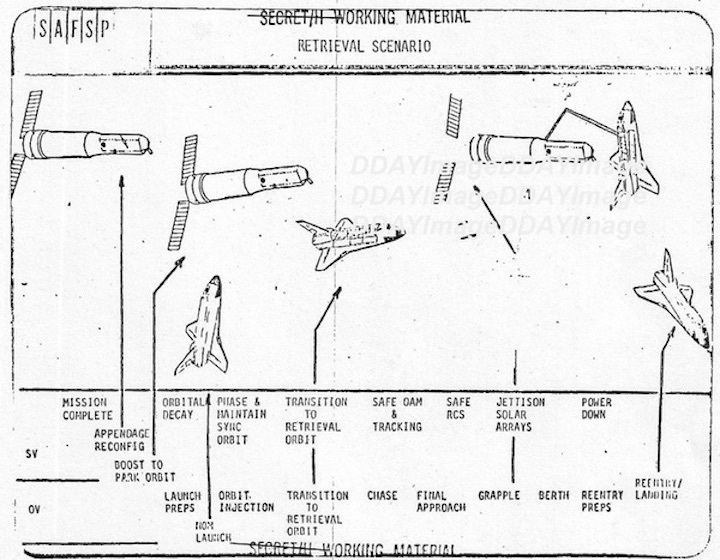
Declassified schematic showing the recovery sequence for a HEXAGON satellite. (credit: NRO)
-
A last hurrah, and a boom
That August 1985 KENNEN launch failure was the beginning of a very bad run of luck for the United States in space. In January 1986 the space shuttle Challenger exploded in a cold Florida sky, killing its seven-person crew and throwing American space launch plans into substantial disarray. In April 1986, the last HEXAGON vehicle was mounted atop its Titan 34D rocket at Vandenberg. The rocket lifted up off the ground, rose only a few hundred meters, and erupted into a big ugly toxic cloud, raining debris all over the launch pad. (See “Death of a monster,”The Space Review, December 15, 2008) As the former NRO official added, the bad luck for the reconnaissance program had really begun with the 1984 HEXAGON mission’s problems, and “actually made Vehicle 20 more critical, and then it blew up.”
The failure destroyed the last HEXAGON and left the United States with only one reconnaissance satellite in orbit. Making matters worse, the explosion had damaged the only pad capable of launching the big Titan rockets necessary for lofting the KENNEN satellites. Nobody had envisioned a string of failures in multiple launch vehicles like the dark days of the mid-1980s. Adding insult to injury, a Delta rocket carrying a weather satellite launched from Cape Canaveral in May 1986 and also suffered a failure—four rockets lost in nine months, seven American lives, billions of dollars worth of equipment, and a critical reconnaissance shortfall for the United States intelligence community in the middle of the Cold War.
This reconnaissance gap was serious, and it prompted some people in the intelligence community to revisit a proposal that had been rejected in the late 1970s—flying a space shuttle with HEXAGON cameras in its payload bay on a manned reconnaissance mission.
Phil Pressel, a HEXAGON project engineer who currently runs a blog dedicated to the HEXAGON, remembers that he was involved in a late 1970s study by Perkin-Elmer, which manufactured HEXAGON’s optical system, to use the HEXAGON development camera in the space shuttle payload bay. The development camera was used for ground testing and had been continuously updated throughout the program. No study report about Perkin-Elmer’s “palletized HEXAGON camera” system has been declassified, although it is mentioned in at least one declassified document dating from late 1979. Somebody wrote next to it “currently underway.” Pressel remembers only that it was a feasibility study, not actual hardware design.
Pressel also remembers that after the final HEXAGON vehicle was destroyed in the April 1986 launch vehicle accident, Perkin-Elmer went to NRO officials with a proposal to fly a shuttle mission using a palletized HEXAGON camera system. However, the NRO rejected the Perkin-Elmer proposal. The HEXAGON development camera, although it had been upgraded regularly over the years, had also been heavily used in ground testing and was not really capable of flight. It sat in classified storage for the next 25 years before the program was finally declassified in 2011. That camera system is now on display at the National Museum of the United States Air Force in Dayton, Ohio.
By 1986, HEXAGON was gone and KENNEN had taken over its mission. But although the digital imaging satellite was a more modern technology, it was never capable of doing everything that the dedicated HEXAGON search system could do. A few years later, something happened that highlighted just how much the intelligence community had lost when they retired the big bird.
Quelle: TheSpaceRview
